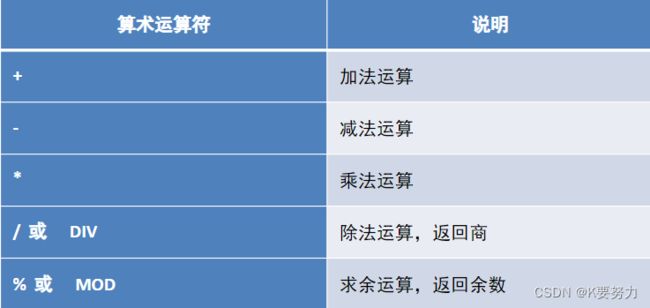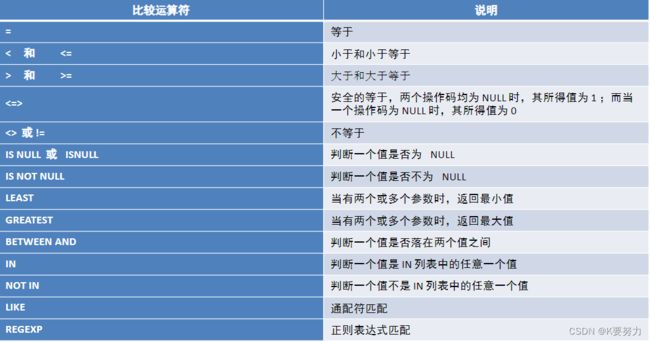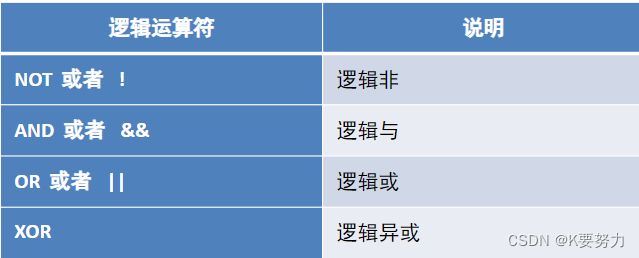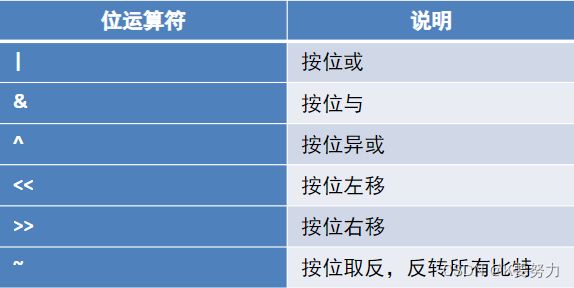MySQL数据库基本操作2
文章目录
- 主要内容
- 一.DQL
-
-
- 1.语法格式
-
-
- 代码如下(示例):
-
- 2.数据准备
-
-
- 代码如下(示例):
-
- 3.简单查询
-
-
- 代码如下(示例):
-
- 4.运算符
- 5.运算符操作-算术运算符
-
-
- 代码如下(示例):
-
- 6.运算符操作-条件查询
-
-
-
- 代码如下(示例):
-
- 7.运算符操作-算数运算符
-
-
- 代码如下(示例):
-
- 8.运算符操作-位运算符
-
-
- 代码如下(示例):
-
- 9.排序查询
-
-
- 代码如下(示例):
-
- 10.聚合查询
-
-
- 代码如下(示例):
-
- 11.聚合查询-null值处理
-
-
- 代码如下(示例):
-
- 12.分组查询-group by
-
-
- 代码如下(示例):
-
- 13.分页查询-limit
-
-
- 代码如下(示例):
-
-
-
- 总结
主要内容
- DQL
一.DQL
DQL(Data Query Language)是一种用于查询数据库中数据的语言。它是SQL(Structured Query Language)的一部分,用于从数据库中检索所需的数据。
DQL的用法如下:
-
SELECT语句:用于从数据库中选择数据。可以选择指定的列、特定的行或者使用聚合函数进行计算。例如:
SELECT column1, column2 FROM table_name; SELECT * FROM table_name; -
WHERE子句:用于指定查询条件,过滤满足条件的数据。可以使用比较运算符(如等于、大于、小于等)、逻辑运算符(如AND、OR)和通配符(如LIKE)来构建条件。例如:
SELECT column1, column2 FROM table_name WHERE condition; SELECT * FROM table_name WHERE column1 = 'value'; -
ORDER BY子句:用于对查询结果进行排序。可以按照指定的列升序或降序排列。例如:
SELECT column1, column2 FROM table_name ORDER BY column1 ASC; SELECT * FROM table_name ORDER BY column1 DESC; -
GROUP BY子句:用于将查询结果按照指定的列进行分组。通常与聚合函数(如SUM、COUNT、AVG等)一起使用。例如:
SELECT column1, SUM(column2) FROM table_name GROUP BY column1; -
HAVING子句:用于在GROUP BY子句后对分组进行过滤。可以使用聚合函数和比较运算符来构建条件。例如:
SELECT column1, SUM(column2) FROM table_name GROUP BY column1 HAVING SUM(column2) > 100; -
LIMIT子句:用于限制查询结果的数量。可以指定返回的行数或者跳过指定数量的行。例如:
SELECT column1, column2 FROM table_name LIMIT 10; SELECT column1, column2 FROM table_name LIMIT 10 OFFSET 5;
以上是DQL的一些常用用法,可以根据具体需求灵活运用。
1.语法格式
代码如下(示例):
select
[all|distinct]
< 目标列的表达式 1> [ 别名 ],
< 目标列的表达式 2> [ 别名 ]...
from < 表名或视图名 > [ 别名 ],< 表名或视图名 > [ 别名 ]...
[where< 条件表达式 >]
[group by < 列名 >
[having < 条件表达式 >]]
[order by < 列名 > [asc|desc]]
[limit < 数字或者列表 >];
简化版语法
select *| 列名 from 表 where 条件
2.数据准备
代码如下(示例):
创建数据库和表
--创建数据库
create database if not exist mydb2;
use mydb2;
-- 创建商品表:
create table product(
pid int primary key auto_increment, -- 商品编号
pname varchar(20) not null , -- 商品名字
price double, -- 商品价格
category_id varchar(20) -- 商品所属分类
);
• 添加数据:
insert into product values(null,' 海尔洗衣机 ',5000,'c001');
insert into product values(null,' 美的冰箱 ',3000,'c001');
insert into product values(null,' 格力空调 ',5000,'c001');
insert into product values(null,' 九阳电饭煲’ ,200,'c001');
insert into product values(null,' 劲霸休闲裤 ',266,'c002');
insert into product values(null,' 海澜之家卫衣 ',180,'c002');
insert into product values(null,' 杰克琼斯运动裤 ',430,'c002');
insert into product values(null,' 兰蔻面霜 ',300,'c003');
insert into product values(null,' 雅诗兰黛精华水 ',200,'c003');
insert into product values(null,' 香奈儿香水 ',350,'c003');
insert into product values(null,'SK-II 神仙水 ',350,'c003');
insert into product values(null,' 资生堂粉底液 ',180,'c003');
insert into product values(null,' 老北京方便面 ',56,'c004');
insert into product values(null,' 良品铺子海带丝 ',17,'c004');
insert into product values(null,' 三只松鼠坚果 ',88,null);
3.简单查询
代码如下(示例):
-- 1. 查询所有商品
select * from product;
-- 2. 查询商品名和商品价格 .
select pname,price from product;
-- 3. 别名查询 . 使用的关键字是 as ( as 可以省略的) .
-- 3.1 表别名 :
select * from product as p;
-- 3.2 列别名:
select pname as pn from product;
-- 4. 去掉重复值 .
select distinct price from product;
-- 5. 查询结果是表达式(运算查询):将所有商品的价格 +10 元进行显示 .
select pname,price+10 from product;
4.运算符
5.运算符操作-算术运算符
代码如下(示例):
select 6 + 2;
select 6 - 2;
select 6 * 2;
select 6 / 2;
select 6 % 2;
-- 将每件商品的价格加 10
select name,price + 10 as new_price from product;
-- 将所有商品的价格上调 10%
select pname,price * 1.1 as new_price from product;
6.运算符操作-条件查询
代码如下(示例):
--查询商品名称为“海尔洗衣机”的商品所有信息:
select * from product where pname = ' 海尔洗衣机 ';
-- 查询价格为 800 商品
select * from product where price = 800;
-- 查询价格不是 800 的所有商品
select * from product where price != 800;
select * from product where price <> 800;
select * from product where not(price = 800);
-- 查询商品价格大于 60 元的所有商品信息
select * from product where price > 60;
-- 查询商品价格在 200 到 1000 之间所有商品
select * from product where price >= 200 and price <=1000;
select * from product where price between 200 and 1000;
7.运算符操作-算数运算符
代码如下(示例):
--查询商品价格是200或800的所有商品
select * from product where price = 200 or price = 800;
select * from product where price in (200,800);
-- 查询含有‘裤 ' 字的所有商品
select * from product where pname like ‘% 裤 %';
-- 查询以 ' 海 ' 开头的所有商品
select * from product where pname like ' 海 %';
-- 查询第二个字为 ' 蔻 ' 的所有商品
select * from product where pname like '_ 蔻 %';
-- 查询 category_id 为 null 的商品
select * from product where category_id is null;
-- 查询 category_id 不为 null 分类的商品
select * from product where category_id is not null;
--使用least求最小值
select least(10, 20, 30); -- 10
select least(10, null , 30); -- null
-- 使用 greatest 求最大值
select greatest(10, 20, 30);
select greatest(10, null, 30); -- null
8.运算符操作-位运算符
代码如下(示例):
select 3&5; -- 位与
select 3|5; -- 位或
select 3^5; -- 位异或
select 3>>1; -- 位左移
select 3<<1; -- 位右移
select ~3; -- 位取反
9.排序查询
代码如下(示例):
• 介绍
如果我们需要对读取的数据进行排序,我们就可以使用 MySQL 的 order by子句来设定你想按哪个字段哪种方式来进行排序,再返回搜索结果。
select
字段名 1 ,字段名 2 ,......
from 表名
order by 字段名 1 [asc|desc] ,字段名 2[asc|desc]......
• 特点
1.asc 代表升序, desc 代表降序,如果不写默认升序
2.order by 用于子句中可以支持单个字段,多个字段,表达式,函数,别名
3.order by 子句,放在查询语句的最后面。 LIMIT 子句除外
--1.使用价格排序(降序)
select * from product order by price desc;
-- 2. 在价格排序 ( 降序 ) 的基础上,以分类排序 ( 降序 )
select * from product order by price desc,category_id asc;
-- 3. 显示商品的价格 ( 去重复 ) ,并排序 ( 降序 )
select distinct price from product order by price desc;
10.聚合查询
操作
代码如下(示例):
-- 1 查询商品的总条数
select count(*) from product;
-- 2 查询价格大于 200 商品的总条数
select count(*) from product where price > 200;
-- 3 查询分类为 'c001' 的所有商品的总和
select sum(price) from product where category_id = 'c001';
-- 4 查询商品的最大价格
select max(price) from product;
-- 5 查询商品的最小价格
select min(price) from product;
-- 6 查询分类为 'c002' 所有商品的平均价格
select avg(price) from product where category_id = 'c002';
11.聚合查询-null值处理
- count 函数对 null 值的处理如果 count 函数的参数为星号( *),则统计所有记录的个数。而如果参数为某字段,不统计含 null 值的记录个数。
- sum 和 avg 函数对 null值的处理这两个函数忽略 null 值的存在,就好象该条记录不存在一样。
- max 和 min 函数对 null 值的处理max 和 min 两个函数同样忽略 null 值的存在。
代码如下(示例):
-- 创建表
create table test_null(
c1 varchar(20),
c2 int
);
-- 插入数据
insert into test_null values('aaa',3);
insert into test_null values('bbb',3);
insert into test_null values('ccc',null);
insert into test_null values('ddd',6);
-- 测试
select count(*), count(1), count(c2) from test_null;
select sum(c2),max(c2),min(c2),avg(c2) from test_null;
12.分组查询-group by
代码如下(示例):
分组查询是指使用 group by 字句对查询信息进行分组。
格式:
-- 1 统计各个分类商品的个数
select category_id ,count(*) from product group by category_id ;
操作
select 字段 1, 字段 2... from 表名 group by 分组字段 having 分组条件 ;
如果要进行分组的话,则 SELECT 子句之后,只能出现分组的字段和统计函数,其他的字段不能出现:
• 分组之后的条件筛选 -having
分组之后对统计结果进行筛选的话必须使用 having ,不能使用 where
where 子句用来筛选 FROM 子句中指定的操作所产生的行
group by 子句用来分组 WHERE 子句的输出。
having 子句用来从分组的结果中筛选行
• 格式
select 字段 1, 字段 2... from 表名 group by 分组字段 having 分组条件 ;
• 操作
-- 2. 统计各个分类商品的个数 , 且只显示个数大于 4 的信息
select category_id ,count(*) from product group by category_id having count(*) > 1;
13.分页查询-limit
代码如下(示例):
分页查询:
分页查询在项目开发中常见,由于数据量很大,显示屏长度有限,因此对数据需要采取分页显示方式。
例如数据共有 30 条,每页显示 5 条,第一页显示 1-5 条,第二页显示 6-10 条。
• 格式
-- 方式 1- 显示前 n 条
select 字段 1 ,字段 2... from 表明 limit n
-- 方式 2- 分页显示
select 字段 1 ,字段 2... from 表明 limit m,n
m: 整数,表示从第几条索引开始,计算方式 (当前页 -1 ) * 每页显示条数
n: 整数,表示查询多少条数据
• 操作
-- 查询 product 表的前 5 条记录
select * from product limit 5
-- 从第 4 条开始显示,显示 5 条
select * from product limit 3,5
INSERT INTO SELECT 语句
格式
insert into Table2(field1,field2,...) select value1,value2,... from Table1
或者:
insert into Table2 select * from Table1
总结
以上是今天要讲的内容,学到了MySQL数据库基本语句及基本操作,包括DQL。




